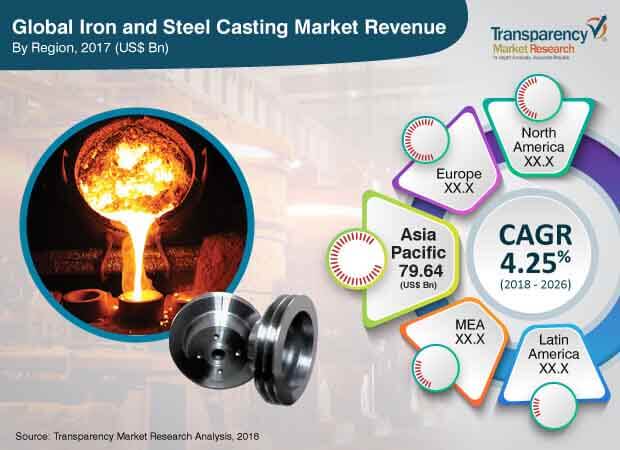Iron and Steel Casting Market - Snapshot
Iron and steel casting refers to the process of injecting or pouring molten iron and steel into a mold to form an object of the desired shape. The process is normally used for mass production of components or parts used in a wide range of sectors such as automotive, agriculture, power generation, oil & gas, manufacturing machinery, and industrial units.
Request PDF Brochure :https://www.transparencymarketresearch.com/sample/sample.php?flag=B&rep_id=20456
Construction industry to be a major market driver
Construction equipment need to be sturdy, strong, and long lasting. They need to incur low costs for maintenance and withstand varying pressures and different climatic conditions. This type of equipment also requires raw materials with excellent properties. Hence, iron and steel are among the most commonly used raw materials in the production of construction equipment. Iron and steel cast products are also used in other heavy industries such as automotive, mining, power generation, manufacturing machinery, oil & gas, electricals, and industrial equipment.

Request For Discount :https://www.transparencymarketresearch.com/sample/sample.php?flag=D&rep_id=20456
Aluminum alloy acts as a major substitute for iron and steel, thereby restraining market
In recent years, manufacturers have shifted their focus toward cast aluminum from conventional iron and steel products for use in automobile components, owing to superior properties of aluminum cast products such as lightness, corrosion resistance, and high performance. For example, the Aluminum Association’s Aluminum Transportation Group (ATG) explains that usage of aluminum components in vehicles can boost economy, owing to the lower total carbon footprint of aluminum compared to other materials, in terms of full life cycle of vehicles. The less a vehicle weighs, the less fuel and power are required. This, in turn, results in high fuel efficiency of engines and less carbon dioxide emissions from vehicles.
Investment in infrastructure by governments to provide significant opportunities to iron and steel casting market
Governments all over the world are planning to invest in infrastructure development projects. Developed countries such as the U.S., Canada, the U.K., France, and Germany are expected to invest in the maintenance of existing infrastructure projects while also developing new projects. On the other hand, developing countries such as India, China, Brazil, and South Africa are expected to invest in the development of new projects. Infrastructure projects such as railways, ports, bridges, manufacturing facilities, and industrial units require a considerable amount of iron and steel casting products such as steel plates and construction equipment such as loaders. These construction equipment also contain iron and steel cast components and parts. Thus, rising investments in infrastructure development are likely to boost the iron and steel casting market during the forecast period.
Explore Transparency Market Research’s award-winning coverage of the global Industry:https://www.prnewswire.com/news-releases/booming-construction-sector-may-prove-beneficial-for-growth-of-gypsum-based-products-market-during-assessment-period-of-2020-2030-tmr-301164787.html
Gray iron is the most commonly used casting material due to its durability and malleability
Gray iron can be defined as a type of cast iron with more than 2% of carbon content and a graphitic microstructure. It is the most commonly used type of iron for casting purposes. It is relatively inexpensive, malleable, and durable. High use of gray iron can be ascribed to various factors such as its tensile and yield strength, ductility, impact resistance, and low production cost. High carbon content of gray iron also makes it easy to melt, weld, and machine into parts.
However, market share of the gray iron segment is expected to decrease marginally, due to rising preference for other materials. On the other hand, the market share of the ductile iron segment is expected to increase during the forecast period. The segment is likely to be driven by the ability of ductile iron to be developed into low-weight iron castings. This reduces delivery expenses and offers economic benefits through other factors such as design and metallurgical flexibility.
Automotive & transport sector the leading consumer of iron and steel casting products
The automotive & transport sector is the major consumer of iron and steel casting products. High tensile strength and impact resistance of iron and steel cast products make them highly suitable for use in a wide range of automotive parts such as flywheels, reducer shells, braking systems, transmission cases, and investment castings. The automotive & transport segment is expected to gain market share by 2026, due to increasing use of private and public transport across the world.
The share of the pipes & fittings segment is likely to increase, due to rising use of pipes and fittings made of iron and steel in industries such as power generation, oil & gas, and manufacturing. Nearly all types of iron and steel casting products are used in the production of pipes and fittings and associated components.
About Us:
Transparency Market Research is a global market intelligence company, providing global business information reports and services. Our exclusive blend of quantitative forecasting and trends analysis provides forward-looking insight for thousands of decision makers. Our experienced team of Analysts, Researchers, and Consultants, use proprietary data sources and various tools and techniques to gather, and analyze information.
Our data repository is continuously updated and revised by a team of research experts, so that it always reflects the latest trends and information. With a broad research and analysis capability, Transparency Market Research employs rigorous primary and secondary research techniques in developing distinctive data sets and research material for business reports.



0 Comments